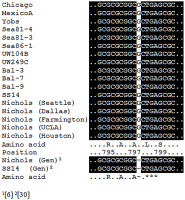Footprint of positive selection in Treponema pallidum subsp. pallidum genome sequences suggests adaptive microevolution of the syphilis pathogen
- PMID: 22720110
- PMCID: PMC3373638
- DOI: 10.1371/journal.pntd.0001698
Footprint of positive selection in Treponema pallidum subsp. pallidum genome sequences suggests adaptive microevolution of the syphilis pathogen
Abstract
In the rabbit model of syphilis, infection phenotypes associated with the Nichols and Chicago strains of Treponema pallidum (T. pallidum), though similar, are not identical. Between these strains, significant differences are found in expression of, and antibody responses to some candidate virulence factors, suggesting the existence of functional genetic differences between isolates. The Chicago strain genome was therefore sequenced and compared to the Nichols genome, available since 1998. Initial comparative analysis suggested the presence of 44 single nucleotide polymorphisms (SNPs), 103 small (≤3 nucleotides) indels, and 1 large (1204 bp) insertion in the Chicago genome with respect to the Nichols genome. To confirm the above findings, Sanger sequencing was performed on most loci carrying differences using DNA from Chicago and the Nichols strain used in the original T. pallidum genome project. A majority of the previously identified differences were found to be due to errors in the published Nichols genome, while the accuracy of the Chicago genome was confirmed. However, 20 SNPs were confirmed between the two genomes, and 16 (80.0%) were found in coding regions, with all being of non-synonymous nature, strongly indicating action of positive selection. Sequencing of 16 genomic loci harboring SNPs in 12 additional T. pallidum strains, (SS14, Bal 3, Bal 7, Bal 9, Sea 81-3, Sea 81-8, Sea 86-1, Sea 87-1, Mexico A, UW231B, UW236B, and UW249C), was used to identify "Chicago-" or "Nichols -specific" differences. All but one of the 16 SNPs were "Nichols-specific", with Chicago having identical sequences at these positions to almost all of the additional strains examined. These mutations could reflect differential adaptation of the Nichols strain to the rabbit host or pathoadaptive mutations acquired during human infection. Our findings indicate that SNPs among T. pallidum strains emerge under positive selection and, therefore, are likely to be functional in nature.
Conflict of interest statement
The authors have declared that no competing interests exist.
Figures


References
-
- Gerbase AC, Rowley JT, Heymann DH, Berkely SF, Piot P. Global prevalence and incidence estimates of selected curable STDs. Sex Transm Infect. 1998;74:S12–16. - PubMed
-
- Greenblatt RM, Lukehart SA, Plummer FA, Quinn TC, Critchlow CW, et al. Genital ulceration as a risk factor for human immunodeficiency virus infection. Aids. 1988;2:47–50. - PubMed
-
- Chesson HW, Pinkerton SD, Irwin KL, Rein D, Kassler WJ. New HIV cases attributable to syphilis in the USA: estimates from a simplified transmission model. AIDS. 1999;13:1387–1396. - PubMed
-
- Schmid GP, Stoner BP, Hawkes S, Broutet N. The Need and Plan for Global Elimination of Congenital Syphilis. Sex Transm Dis. 2007;34:S5–S10. - PubMed
Publication types
MeSH terms
Substances
Grants and funding
LinkOut - more resources
Full Text Sources
Medical

